-

人教版高中英语必修3Healthy Eating说课稿4篇
Language learning needs a context, which can help the learners to understand the language and then can product comprehensible output, so computer has the advantages to make the materials attractive.Part 3 Learning MethodsTask-based, self-dependent and cooperative learningPart 4 Teaching ProcedureStep One Lead-in“Interest is the best teacher.” Therefore, at the very beginning of the class, I should spark the students’ mind to focus on the centre topic “the band”. I’ll show some pictures of food to attract their attention and then bring some questions.Question:What kind of food they like?What should go into a good meal?The answers must relate to the diet. After this, the students will be eager to know something about a balance diet and this is the very time to naturally lead the class into Step 2Step 2 Reading for information: skimming and scanning In this step, I use Task-based Language Teaching method, which can give students a clear and specific purpose while skimming and scanning the context.Task 1 General ideaThe students will be asked to just glance at the title and the pictures of the passage, and then guess what they will read in the text. And they’ll be divided into groups of four to have a discussion.The purpose is to inspire the students to read actively, not passively. In addition, the task is to develop the students’ reading skill by making prediction and to encourage the students to express their thoughts in English and cooperate with each other.Task 2 Main idea of each paragraphCooperative learning can raise the students’ interest and create an atmosphere of achievement. Based on this theory, I divide the whole class into 4 groups to skim the whole text and get the main idea of each paragraph.

人教版高中英语必修4Working The Land说课稿3篇
Knowledge objectives:(1) to make Ss grasp the usage of words, expressions and sentence structures: statistics, struggle, thanks to, rid of, some patterns for persuasion, the “ing” form as subject and object;(2)to use learnt knowledge to persuade sb.Ability objectives:(1) to develop Ss’ reading skills(skimming, scanning, word guessing);(2) to improve Ss’ speaking, communicating and cooperating skills.Emotional objectives:to make Ss know the contribution of Yuan,and learn his spirit and his simple life time.Teaching important and difficult points:(1) some words, expressions and sentence structures mentioned above;(2)the content of the text;(3)training their reading and speaking skills.Teaching methods: CLT, TBLT,QT.Learning strategies: CLS, QLS, TBLS.Teaching procedures:Step 1 lead-in: (1) teacher plays a piece of recent news from CCTV about the harvest of the super hybrid rice, and ask students whether they know Yuan or not, and talk about him and his contribution.(2)Brain storm: let Ss describe Yuan in their minds including his appearance, his living condition and so on.Step 2 fast reading tasks:(1)teacher introduces Yuan and super hybrid rice(2)make Ss read the text as fast as possible with questions. Such as: what’s the general ideaof this passage? What’s Yuan’ dream? (skimming and scanning skill)Step 3 intensive reading tasks(1)let Ss read the text silently, find topic sentence of each paragraph and draw the difficult sentences and the knowledge what they don’t understand.(words guessing)(2)teacher and Ss talk about the important words, expressions and sentences together, and ask Ss to retell the content of the text.(summarizing and paraphrasing)(3)teacher summarize this part.(4) read again following the courseware.

人教版高中英语必修3The million pound bank note说课稿3篇
在接下来的细读环节,我套用了高考对阅读理解的考查方式设置了5个问题,分别为三个推理判断题,一个细节题和一个主旨大意题。学生需要对文章的内容进行分析、归纳、推理、猜测等高级思维活动才能做出正确的回答。【设计意图】这一过程是对学生进行细读的训练,培养学生获取特定信息和挖掘文章深层次信息的能力。第三环节:Intensive-reading (精读) 15′第三个环节精读,既是最重要的环节,也是突破本课重难点的关键。首先,让学生思考剧本中人物看到百万英镑前后的态度发生了怎样的变化。其次,让学生仔细阅读文章,找出可以表现人物态度变化的具体的语言和动作。最后,让学生总结人物的态度发生变化的根本原因是什么,从而引出Money Talks, 供学生思考。【设计意图】通过一系列的活动培养学生学习从人物的语言和动作探究人物的心理,使学生进一步体会戏剧语言的魅力,从而对文章背后所反映的社会问题进行思考,也为下一步的讨论环节做好铺垫。

人教版高中英语必修5First aid说课稿6篇
In this class, I have 3 teaching aims, that is, knowledge aims, ability aims and emotion aims.1) Knowledge-Teach students new words and expressions, such as temporary, bleed,sprain choke, first aid, fall ill and so on.-Enable students to have a better understanding for some basic knowledge of first aid.2) Ability-Train students’ speaking, reading and writing abilities by different teaching activities, such as skimming, comprehending, team work, role play, retelling and writing.-Develop students’ reading strategy on how to move general idea to specific information.3) Emotion-Promote students’ awareness of giving first aid.- Cultivate students’ creativities.Then let’s come to my teaching methods and activities.III. Teaching methods and activities:To achieve different teaching aims, various kinds of teaching methods and activities will be adopted throughout this period, such as TBL (task-based learning), skimming, team work, brainstorm and others, which can offer students opportunities to fulfill tasks in which they can use language to achieve a specific outcome.IV. Teaching aids:Computer and blackboardV. Teaching important points:1) Make students have a clear mind for the structure of the text.2) Help students understand the theme of the text.VI. Teaching difficulties:1) So many new words may affect students’ understanding.2) How to get students to know about the functions of the skin and thecauses, characteristics and treatments for different degree burns,and the knowledge about giving first aid. VII. Blackboard design:

人教版高中英语必修5Great scientists说课稿4篇
通过写文章梗概,培养学生综合运用语言的能力,学习用恰当的英语描述科学家的故事。这是本课的教学难点。教师可以使用完形填空的方式来帮助学生整理语篇,从而来降低难度。本课的教学重点的突破方法是:在阅读前,让学生初步了解得出科学观点所需要的基本程序,从而轻松而自然地导入文章的阅读;在阅读过程中,由易到难设计快速阅读和精读的问题,层层推进各种阅读活动,让学生对阅读内容从整体感知到细节理解,最后深层读懂整篇文章,同时加强阅读策略的指导,让每个学生都主动参与课堂教学活动,最终达到提高阅读能力的目的。Step 4 Post-readingGroup Activities四人小组共同合作,在老师的适当指导下,就以下2个问题展开讨论,让学生就所知、所学、所感和所想融入话题,然后抽若干同学代表作小组发言。1. What do you think about John Snow, and what should we learn from him?2. Cholera was 19th century disease, which two diseases are similar to cholera today? Why?

人教版高中英语必修5Life in the Future说课稿5篇
Good afternoon, everyone. It’s my great pleasure to be here sharing my lesson with you. The content of my lesson is Senior English for China Book5 Unit 3 Life in the Future. I’ll be ready to begin this lesson from six parts: Analysis of the teaching material, Analysis of the students, Teaching aims and important and difficult points, Teaching methods and aids, Teaching procedures, and Blackboard design. First, let me talk about the teaching material.Part 1 Analysis of the Teaching Material:This unit is about what human beings’ life will be like in about one thousand years. By studying of this unit, we’ll Enable the students to know the changes in humans’ life and some new inventions bringing about the change and develop the interest in science. This lesson plays an important part in the English teaching in this unit. This is an important lesson in Book Five. From this lesson, it starts asking the Ss to grasp contents of each passage. Therefore, this lesson is in the important position of the teaching material. If the Ss can learn it well, it will be helpful to make the Ss learn the rest of this unit.Part 2 Analysis of the SsAs Senior2 Ss, they are at different levels of English fluency, some of them have lost interest in English. So during the lesson, I arrange a variety of activities to let all of them join in to attract their interest and let them be confident and taste the joy of success.

人教版高中英语必修5Making the news说课稿4篇
今天我们来介绍一下必修五第四单元的授课方式。这个单元的题目是Making the news。应该是学生比较感兴趣的话题,学生往往对新闻工作充满好奇,所以我们可以利用这个机会多设计一些师生互动和学生互动,来激发起学习的积极性,提高学习效率。同时我们可以利用这个单元不仅帮助学生掌握语言知识,培养语言能力,同时让其了解新闻工作的重要性,培养起社会智能感。这个单元分为六个课时,它的教学目标是这样的:语言目标是掌握词汇表中的常用单词和短语,掌握倒装句的一些基本用法。 技能目标是能初步掌握约会的基本句型并在真实的场景下正确运用。新闻报道类文章的写作技能。采访的基本规范和沟通技能。情感目标是对新闻报道的客观性和真实性有更好的理解。对新闻记者的职业有更深入的了解,并能体会其工作的重要性。下面我们来介绍一下第一课时的授课方式,第一课的教学目标是这样的第一课时的教学目标语言目标:单词:Occupation, journalist, editor, photographer, curious, personality, enthusiasm

人教版高中英语必修5The United Kingdom说课稿4篇
Teaching Aims:Knowledge 1. Get the students to learn the useful new words and expressions in this section. Aims:2. Let the students learn about how the UK was formed and the four groups of invaders.1. Develop students’ reading ability and let them learn different Ability reading skills. Aims:2. Enable students to learn to talk about the United Kingdom and the Union Jack Emotional 1. Let students know more about the UK2. Develop students’ sense of cooperative learning Aims:Teaching Important Points:1. Let the students learn about the countries of the United Kingdom and the Union Jack2. Get the students to read the passage and know about how the UK was formed and the four groups of invaders.3. Have the students learn different reading skills.Teaching Difficult Ponts:1. Develop students’ reading ability.2. Enable students to talk about the United Kingdom and the Union Jack.3. Let students learn how the UK was formed geographically and historically.Teaching Methods:Showing pictures, asking, exercising, listening, reading etc.Teaching Aids:A computer,a projector and a blackboard.Teaching Procedures: 1) Show a map of the world, ask students the following questions:Where is the UK?What’s the full name of the UK?2) Ask the students work in pairs to do the quiz on Page 9.Do you want to test how many things you know about the United Kingdom? Let’s have a small test.Using the map on P9, students answer the following questions:?How many countries does the UK consist of? What are they??England is divided into three main areas. Do you know what they are? 1) Scanning (10Minutes )Let the students hold the questions asked in pre-reading and read the passagequickly and then let them do the following exercise.Join lines to the right answer.
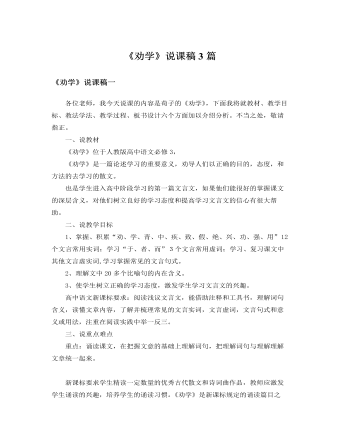
人教版高中语文必修3《劝学》说课稿3篇
《劝学》是普通高中课程标准试验教科书语文必修三第三单元的重点篇目,该文集中反映著名思想家荀子在学习问题上的观点和精彩斐然的论证艺术。该单元所选课文都是古代的议论性散文。通过本单元的学习在于让学生感受我国传统文化的精神,掌握基础的文言语法知识,学习如何清晰有力的表达自己的思想和见解。本文安排在单元的第一篇,如何指导学生学好这篇课文,是实现“授之以渔”,树立学生学好文言文的信心,掌握文言学习方法的关键。根据新课标倡导从“知识与能力”、“过程与方法”、“情感态度与价值观”三方面出发设计课程目标的要求和高一的学生对于文言文的知识还在积累的阶段,应该注重基础知识的积累和一定量的诵读的实际情况。我拟确定以下教学目标:1,了解荀子论述学习的思想,明确学习要靠积累、坚持不懈、专心致志的道理。2,掌握积累文言实词、虚词,活用、古今异议等现象和固定句式。
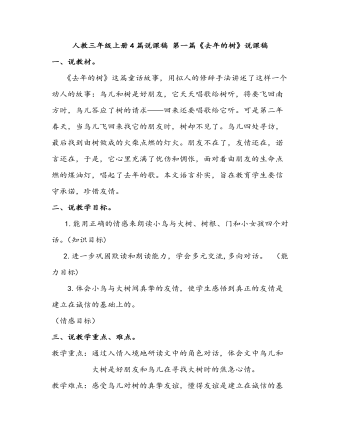
人教版三年级上册语文说课稿
二、说教学目标。 1.能用正确的情感来朗读小鸟与大树、树根、门和小女孩四个对话。(知识目标) 2.进一步巩固默读和朗读能力,学会多元交流,多向对话。 (能力目标) 3.体会小鸟与大树间真挚的友情,使学生感悟到真正的友情是建立在诚信的基础上的。
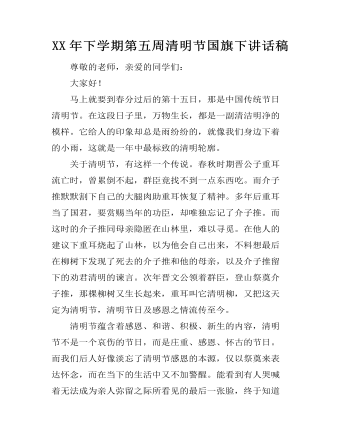
XX年下学期第五周清明节国旗下讲话稿
尊敬的老师,亲爱的同学们:大家好!马上就要到春分过后的第十五日,那是中国传统节日清明节。在这段日子里,万物生长,都是一副清洁明净的模样。它给人的印象却总是雨纷纷的,就像我们身边下着的小雨,这就是一年中最标致的清明轮廓。关于清明节,有这样一个传说。春秋时期晋公子重耳流亡时,曾累倒不起,群臣竟找不到一点东西吃。而介子推默默割下自己的大腿肉助重耳恢复了精神。多年后重耳当了国君,要赏赐当年的功臣,却唯独忘记了介子推。而这时的介子推同母亲隐匿在山林里,难以寻觅。在他人的建议下重耳烧起了山林,以为他会自己出来,不料想最后在柳树下发现了死去的介子推和他的母亲,以及介子推留下的劝君清明的谏言。次年晋文公领着群臣,登山祭奠介子推,那棵柳树又生长起来,重耳叫它清明柳,又把这天定为清明节,清明节日及感恩之情流传至今。
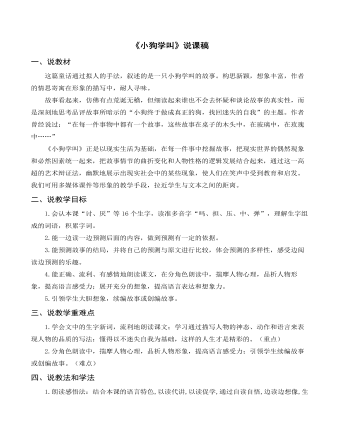
部编人教版三年级上册《小狗学叫》说课稿
一、说教材这篇童话通过拟人的手法,叙述的是一只小狗学叫的故事。构思新颖,想象丰富,作者的情思寄寓在形象的描写中,耐人寻味。 故事看起来,仿佛有点荒诞无稽,但细读起来谁也不会去怀疑和谈论故事的真实性,而是深刻地思考品评故事所暗示的“小狗终于做成真正的狗,找回迷失的自我”的主题。作者曾经说过:“在每一件事物中都有一个故事,这些故事在桌子的木头中,在玻璃中,在玫瑰中……” 《小狗学叫》正是以现实生活为基础,在每一件事中挖掘故事,把现实世界的偶然现象和必然因素统一起来,把故事情节的曲折变化和人物性格的逻辑发展结合起来,通过这一高超的艺术辩证法,幽默地展示出现实社会中的某些现象,使人们在笑声中受到教育和启发。我们可用多媒体课件等形象的教学手段,拉近学生与文本之间的距离。
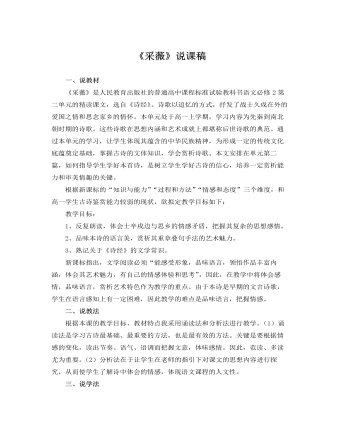
人教版高中语文必修2《采薇》说课稿
三、疏通课文,体会情感学生朗读一至三节,找出通假字,如“莫”;语助词如“止”“曰”;古今异义词如“启”“居”。以及个别短语如“靡室靡家”“载饥载渴”的结构,结合上《卫风·氓》中出现的相同或类似的结构来理解。检查学生的自学情况,抽查翻译,纠正错误。这三节都以采薇起笔,让学生思考课文呢写了薇菜生长的哪几种形态,有什么作用?学生思考。这个问题不难,但学生回答可能不完整,只点到用于表达士卒思归之情的强烈。老师要补充,用薇菜的生长来反映归期的推移和不定期,思念之情更加沉重。同时在艺术手法上,同《卫风·氓》用“桑叶”来起兴一样,这里也是比兴手法,引出下文。另外,战士们靠野菜来充饥也反映了战士们生活艰苦,兴中有赋。
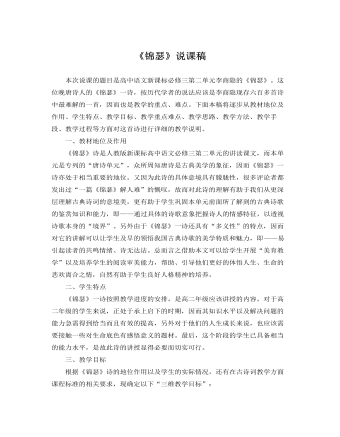
人教版高中语文必修3《锦瑟》说课稿
三、教学目标根据《锦瑟》诗的地位作用以及学生的实际情况,还有在古诗词教学方面课程标准的相关要求,现确定以下“三维教学目标”:(一)知识与技能目标:感受体悟古典诗歌的意境美,发挥合理的主观能动性进行创新性的阅读鉴赏,正确认识意象在诗歌意境中的重要作用。并在上述的基础上提高鉴赏能力和审美情操。(二)过程与方法目标:《锦瑟》诗的讲解采用“引导与自我生成”的方法,从老师的引导开始,以学生的研讨交流再加之教师的总结结束。利用教师引导和师生互动刺激学生的领悟力,提高学生的认知水平与能力。(三)情感态度价值观目标:培养学生在尊重传统文化的基础上热爱祖国自己文化的态度,让学生正确认识古典诗词的精神美。最后在自我感悟中陶冶情操,明心启智。
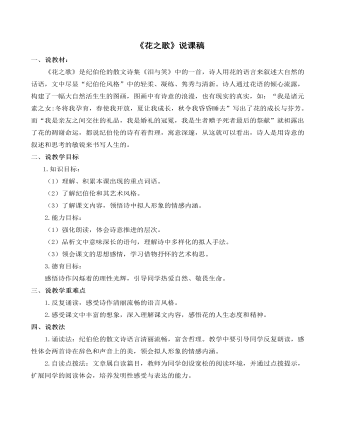
部编人教版六年级上册《花之歌》说课稿
一、说教材: 《花之歌》是纪伯伦的散文诗集《泪与笑》中的一首,诗人用花的语言来叙述大自然的话语,文中尽显“纪伯伦风格”中的轻柔、凝练、隽秀与清新。诗人通过花语的倾心流露,构建了一幅大自然活生生的图画,图画中有诗意的浪漫,也有现实的真实,如:“我是诸元素之女:冬将我孕育,春使我开放,夏让我成长,秋令我昏昏睡去”写出了花的成长与芬芳。而“我是亲友之间交往的礼品,我是婚礼的冠冕,我是生者赠予死者最后的祭献”就袒露出了花的凋谢命运,都说纪伯伦的诗有着哲理,寓意深邃,从这就可以看出,诗人是用诗意的叙述和思考的敏锐来书写人生的。 二、说教学目标 1.知识目标: (1)理解、积累本课出现的重点词语。 (2)了解纪伯伦和其艺术风格。 (3)了解课文内容,领悟诗中拟人形象的情感内涵。
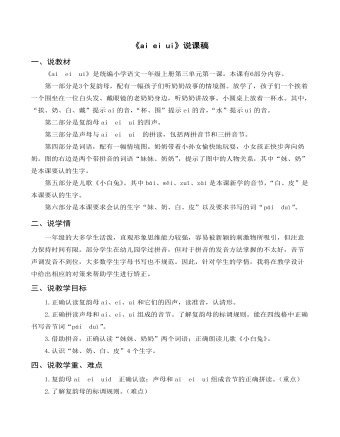
部编人教版一年级上册《ai ei ui》说课稿
一、说教材《ai?ei?ui》是统编小学语文一年级上册第三单元第一课。本课有6部分内容。第一部分是3个复韵母,配有一幅孩子们听奶奶故事的情境图。放学了,孩子们一个挨着一个围坐在一位白头发、戴眼镜的老奶奶身边,听奶奶讲故事。小圆桌上放着一杯水。其中,“挨、奶、白、戴”提示ai的音,“杯、围”提示ei的音,“水”提示ui的音。第二部分是复韵母ai?ei?ui的四声。第三部分是声母与ai?ei?ui?的拼读,包括两拼音节和三拼音节。第四部分是词语,配有一幅情境图。奶奶带着小孙女愉快地玩耍,小女孩正快步奔向奶奶。图的右边是两个带拼音的词语“妹妹、奶奶”,提示了图中的人物关系,其中“妹、奶”是本课要认的生字。第五部分是儿歌《小白兔》。其中bái、wěi、zuǐ、zài是本课新学的音节,“白、皮”是本课要认的生字。第六部分是本课要求会认的生字“妹、奶、白、皮”以及要求书写的词“pái?duì”。

部编人教版一年级上册《g k h》说课稿
2.识记形。(1)观察字形。除了引导学生从情境图中花环、水草和蝌蚪的组合、椅子的侧面等帮助记忆ɡ、k、h的形体外,还要引导学生充分发挥想象来记忆,教师在课前也可以收集一些图片帮助学生记忆。(2)书写字母。声母ɡ、k、h书写指导时,要注意两个新的笔画名称,“”叫竖左弯,“”叫左斜右斜。教师可边示范边讲清字母书写的笔顺和在四线三格中的位置。ɡ两笔写成,占中格和下格。书写时要注意“”的竖要写得直。k两笔写成,占上格和中格。书写时注意“”是一笔完成。h两笔写成,占上格和中格。书写时要注意第一笔竖要占到上格,和n的字形区分开来。(二)拼读教学1.两拼音节。教师要引导学生运用前面所学的方法自己拼读两拼音节,先个体拼读,然后和同伴互相评议。对学生不易区分的ɡù、kǔ、hǔ,教师要加以重点指导。拼读练习时,要和学生熟悉的汉字、事物联系起来,也可以进行适度的拓展,增强趣味性。如:2.三拼音节。这是学生第一次接触三拼音节,拼读难度较大。教师要借助拼读示意图讲清拼读规则,然后联系学生熟悉的事物以及识字单元中已学的“火”字,帮助学生正确拼读,降低难度。
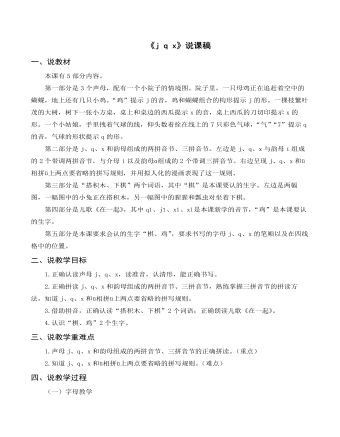
部编人教版一年级上册《j q x》说课稿
本课有5部分内容。第一部分是3个声母,配有一个小院子的情境图。院子里,一只母鸡正在追赶着空中的蝴蝶,地上还有几只小鸡。“鸡”提示j的音,鸡和蝴蝶组合的构形提示j的形。一棵枝繁叶茂的大树,树下一张小方桌,桌上和桌边的西瓜提示x的音,桌上西瓜的刀切印提示x的形。一个小姑娘,手里拽着气球的线,仰头数着拴在线上的7只彩色气球,“气”“7”提示q的音,气球的形状提示q的形。第二部分是j、q、x和韵母组成的两拼音节、三拼音节。左边是j、q、x与韵母i组成的2个带调两拼音节,与介母i以及韵母ɑ组成的2个带调三拼音节。右边呈现j、q、x和ü相拼ü上两点要省略的拼写规则,并用拟人化的漫画表现了这一规则。第三部分是“搭积木、下棋”两个词语,其中“棋”是本课要认的生字。左边是两幅图,一幅图中的小兔正在搭积木,另一幅图中的猩猩和瓢虫对坐着下棋。第四部分是儿歌《在一起》,其中qǐ、jī、xǐ、xì是本课新学的音节,“鸡”是本课要认的生字。第五部分是本课要求会认的生字“棋、鸡”,要求书写的字母j、q、x的笔顺以及在四线格中的位置。二、说教学目标1.正确认读声母j、q、x,读准音,认清形,能正确书写。2.正确拼读j、q、x和韵母组成的两拼音节、三拼音节,熟练掌握三拼音节的拼读方法,知道j、q、x和ü相拼ü上两点要省略的拼写规则。3.借助拼音,正确认读“搭积木、下棋”2个词语;正确朗读儿歌《在一起》。4.认识“棋、鸡”2个生字。
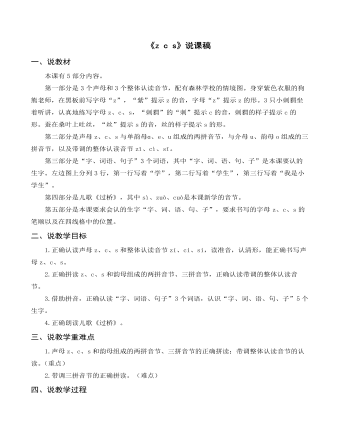
部编人教版一年级上册《z c s》说课稿
一、说教材本课有5部分内容。第一部分是3个声母和3个整体认读音节,配有森林学校的情境图。身穿紫色衣服的狗熊老师,在黑板前写字母“z”,“紫”提示z的音,字母“z”提示z的形。3只小刺猬坐着听讲,认真地练写字母z、c、s,“刺猬”的“刺”提示c的音,刺猬的样子提示c的形。蚕在桑叶上吐丝,“丝”提示s的音,丝的样子提示s的形。第二部分是声母z、c、s与单韵母ɑ、e、u组成的两拼音节,与介母u、韵母o组成的三拼音节,以及带调的整体认读音节zǐ、cì、sī。第三部分是“字、词语、句子”3个词语,其中“字、词、语、句、子”是本课要认的生字。左边图上分列3行,第一行写着“学”,第二行写着“学生”,第三行写着“我是小学生”。第四部分是儿歌《过桥》,其中sì、zuò、cuò是本课新学的音节。第五部分是本课要求会认的生字“字、词、语、句、子”,要求书写的字母z、c、s的笔顺以及在四线格中的位置。
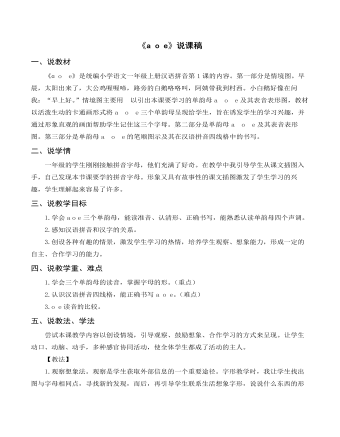
部编人教版一年级上册《a o e》说课稿
一、说教材《ɑ o?e》是统编小学语文一年级上册汉语拼音第1课的内容。第一部分是情境图。早晨,太阳出来了,大公鸡喔喔啼,路旁的白鹅咯咯叫,阿姨带我到村西。小白鹅好像在问我:“早上好。”情境图主要用?以引出本课要学习的单韵母a?o?e及其表音表形图,教材以活泼生动的卡通画形式将a?o?e三个单韵母呈现给学生,旨在诱发学生的学习兴趣,并通过形象直观的画面帮助学生记住这三个字母。第二部分是单韵母a?o?e及其表音表形图。第三部分是单韵母a?o?e的笔顺图示及其在汉语拼音四线格中的书写。二、说学情一年级的学生刚刚接触拼音字母,他们充满了好奇。在教学中我引导学生从课文插图入手,自己发现本节课要学的拼音字母。形象又具有故事性的课文插图激发了学生学习的兴趣,学生理解起来容易了许多。三、说教学目标1.学会a o e 三个单韵母,能读准音、认清形、正确书写,能熟悉认读单韵母四个声调。2.感知汉语拼音和汉字的关系。3.创设各种有趣的情景,激发学生学习的热情,培养学生观察、想象能力,形成一定的自主、合作学习的能力。